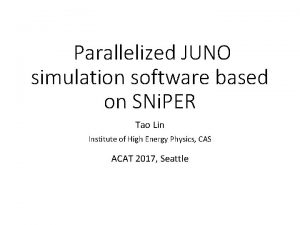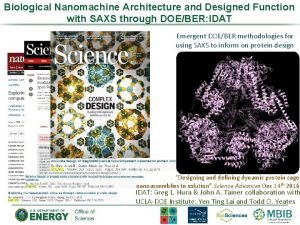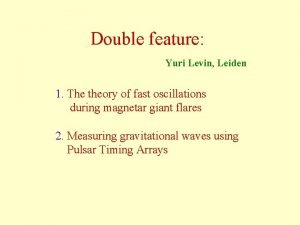Juno Steve Levin Juno Project Scientist April 1






















- Slides: 22

Juno Steve Levin Juno Project Scientist April 1, 2016


Why Jupiter is so Important • It’s the largest planet. • Probably formed first. • Is very much like the Sun in composition. • We lost Earth’s history, but not Jupiter’s.

Juno Mission Overview Salient Features: • First solar-powered mission to Jupiter • Eight science instruments to conduct gravity, magnetic and atmospheric investigations, plus a camera for education and public outreach • Spinning, polar orbiter spacecraft launched on August 5, 2011 – 5 -year cruise to Jupiter, arriving July 4, 2016 – 16 months of science at Jupiter, ending by diving into Jupiter in February 2018 • Elliptical 14 -day orbit swings below radiation belts to minimize radiation exposure • 2 nd mission in NASA’s New Frontiers Program Science Objective: Improve our understanding of giant planet formation and evolution by studying Jupiter’s origin, interior structure, atmospheric composition and dynamics, and magnetosphere Principal Investigator: Scott Bolton Southwest Research Institute

Juno’s Flight Plan, or Trajectory • A five-year trek that loops once around the inner solar system before heading for Jupiter • Why does it take so long to get there? • Direct path would have required a much more powerful launch vehicle • Using Earth’s gravity for a boost makes the trip longer, but saves a lot of rocket cost!

Why Juno? Jupiter is by far the largest planet in the solar system, and we’ve been studying it for hundreds of years. Yet we still have major unanswered questions about this giant planet… • How did Jupiter form? • How is the planet arranged on the inside? • Is there a dense core, and if so, how large is it? • How is its vast magnetic field generated? • How are atmospheric features related to the movement of the deep interior? • What are the physical processes that power the auroras? • What do the poles look like?

Jupiter’s Temperature 1000+ K (bottom) to 110 K (top) 10, 000 K 30, 000 K • Jupiter retains heat from its formation 4. 5 B years ago • It is slowly cooling as heat is transported outwards • The atmosphere cools predictably with altitude (like the Earth)

Probing Deep and Globally Microwave radiometry - Magnetic field - Grav field

Water Oxygen Water is key to understanding the formation of Jupiter.

Juno Science Objectives Origin Determine the abundance of water and place an upper limit on the mass of Jupiter’s dense core to decide which theory of the planet’s origin is correct Interior Understand Jupiter’s interior structure and how material moves deep within the planet by mapping its gravitational and magnetic fields Atmosphere Map variations in atmospheric composition, temperature, cloud opacity and dynamics to depths greater than 100 bars at all latitudes Magnetosphere Characterize and explore threedimensional structure of Jupiter's polar magnetosphere and auroras. Juno Instruments **** Gravity Science (JPL, ASI) **** Magnetometer— MAG (GSFC) **** Microwave Radiometer— MWR (JPL) **** Jupiter Energetic Particle Detector— JEDI (APL) **** Jovian Auroral Distributions Exp. — JADE (Sw. RI) **** Plasma Waves Instrument— Waves (U of Iowa) **** UV Spectrometer— UVS (Sw. RI) **** Infrared Camera— JIRAM (ASI) **** Visible Camera— Juno. Cam (Malin)

Spacecraft & Payload SPACECRAFT DIMENSIONS Diameter: 66 feet (20 meters) Height: 15 feet (4. 5 meters) Juno. Cam UVS Waves (2 detectors) JEDI JIRAM (6 sensors ) JADE Gravity Science (4 sensors ) (2 sensors) Magnetometer (2 sensors, 4 support cameras) MWR (6 sensors )

Microwave Radiometer (MWR) Experiment The microwave antennas are distributed around the spacecraft and view perpendicular to the spacecraft spin axis off-nadir view emission angle nadir view A 6: horn 120° Field of View Along-track scanning A 3 - A 5: slot arrays A 1: patch array A 2: patch array

Sensing the deep atmosphere Juno’s Microwave Radiometer measures thermal radiation from the atmosphere to as deep as 1000 atmospheres pressure (~500 -600 km below the visible cloud tops). Determines water and ammonia abundances in the atmosphere all over the planet Synchrotron radio emission from the radiation belts makes this kind of measurement impossible from far away on Earth

Mapping Jupiter’s gravity Tracking changes in Juno’s velocity reveals Jupiter’s gravity (and how the planet is arranged on the inside). Precise Doppler measurements of spacecraft motion reveal the gravity field. Tides provide further clues.

Atmospheric Dynamics Radiometry investigates atmospheric structure Gravity investigates differential rotation 15

Mapping Jupiter’s magnetic field lets us probe deep inside the planet. Juno’s polar orbit provides complete mapping of planet’s powerful magnetic field.

Exploring the Polar Magnetosphere Jupiter’s magnetosphere near the planet’s poles is a completely unexplored region! Juno’s investigation will provide new insights about how the planet’s enormous magnetic force field generates the aurora. 17

“Science In A Fishbowl” http: //missionjuno. swri. edu click on “Junocam” 18

The Juno/DSN-GAVRT Connection Education and Science • Students contribute to Juno science - Modeling the radiation environment - Providing context for Microwave Radiometer data • Juno science lessons (in and out of the classroom) • Juno scientists participate in GAVRT teacher training • Juno scientists in the (GAVRT) classroom • Future plans (Junocam) Spacecraft tracks

Fly along with Juno is part of NASA’s 3 D interactive, Eyes on the Solar System… solarsystem. nasa. gov/eyes

For more information. . . Ask me questions! Juno mission website: missionjuno. swri. edu On the NASA website: www. nasa. gov/juno

 Steve jobs, steve wozniak, and ronald wayne
Steve jobs, steve wozniak, and ronald wayne Lloyd quarterman parents
Lloyd quarterman parents Scientist project
Scientist project Whos apollo's wife
Whos apollo's wife Juno awards date
Juno awards date Venus roman goddess
Venus roman goddess Amphitrite god of war
Amphitrite god of war Juno docdb
Juno docdb Son of juno
Son of juno Juno genre
Juno genre Hera atributos
Hera atributos Juno
Juno Juno
Juno Why does juno hate aeneas
Why does juno hate aeneas Juno izumo
Juno izumo Kurt levin
Kurt levin Vladimir levin
Vladimir levin Aleksej karenin
Aleksej karenin Levin kurt
Levin kurt Updatehal
Updatehal Pulsar timing
Pulsar timing Henry m levin
Henry m levin Levin ham
Levin ham









































